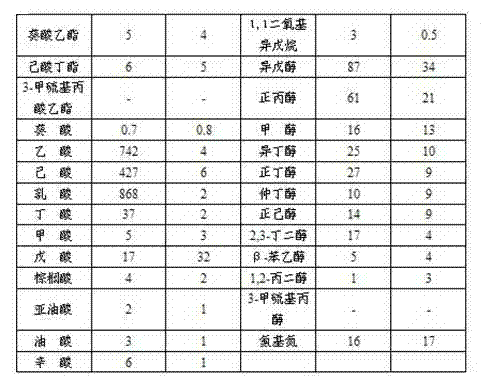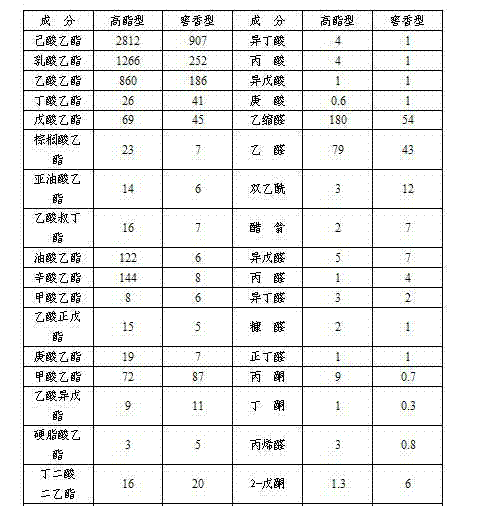Resource and harmless processing method for biggest solid waste distiller's grain of traditional white spirit
A solid waste, harmless treatment technology, applied in the field of environmental protection, can solve the problem of small economic benefits, achieve the effect of improving the extraction rate, saving labor hours, and achieving significant effects
- Summary
- Abstract
- Description
- Claims
- Application Information
AI Technical Summary
Problems solved by technology
Method used
Image
Examples
Embodiment 1
[0052] Example 1 solid state fermentation stage
[0053] Put the discarded grains evenly in the liquor distiller, dry-steam them with 100°C saturated steam for 20 minutes, put them in a retort, and spread them in the air. When the temperature of the discarded grains drops to 60°C, sprinkle them with rehydrated and activated glucoamylase, and mix well; continue to spread in the air Cool down to 50°C, then sprinkle the cellulase after rehydration and activation, add acid protease, mix well; spread it out to cool down to 30°C, and then sprinkle the rehydration-activated high-temperature-resistant active dry yeast Saccharomyces cerevisiae activation solution , and the middle-temperature Daqu, which accounts for 2% of the weight of the grains, are mixed evenly, put into the cellar and fermented at a temperature of 28-30°C for 16 days to obtain grains.
[0054] The residue content of the discarded grains was 9.2% (W / W).
[0055] The rehydrated and activated glucoamylase is obtai...
Embodiment 2
[0061] Embodiment 2 solid-state fermentation stage
[0062] Put the discarded grains evenly in the liquor distiller, dry-steam with 110°C saturated steam for 15 minutes, place in a retort, and spread to dry. When the temperature of the discarded grains drops to 59°C, sprinkle the rehydrated activated glucoamylase and mix well; continue to spread to dry Cool down to 45°C, then sprinkle the rehydrated and activated cellulase, add acid protease, mix well; spread it out to cool down to 28°C, and then sprinkle the rehydrated and activated high temperature-resistant active dry yeast Saccharomyces cerevisiae activation solution , and the middle-temperature Daqu, which accounts for 2% of the weight of the grains, are mixed evenly, put into the cellar and fermented at a temperature of 30-33°C for 12 days to obtain grains.
[0063] The residue content of the discarded grains was 9.2% (W / W).
[0064] The rehydrated and activated glucoamylase is obtained by dissolving 20 times the glucoa...
Embodiment 3
[0073] Embodiment 3 solid-liquid combined fermentation stage
[0074] In the fermented grains prepared in Example 1, add 6% compound esterase and 8% high-temperature Dakoji by weight, mix well, stack at 35°C for 24 hours, then add 10% concentrated hexanoic acid to ferment liquid and 15% distilled grains wine, and finally fermented in the cellar for 8 days to get the fermented grains, the fermentation temperature is 36~40°C.
[0075] The compound esterase is formed by mixing Rhizopus and Monascus in a weight ratio of 7:4.
[0076] The caproic acid content of the concentrated caproic acid fermentation liquid is 28g / L, which is obtained from the fermentation workshop of Sichuan Yinfan Biotechnology Co., Ltd.
[0077] The distilled grains liquor is 57% vol, which is taken from the liquor experiment base of Sichuan Yinfan Biotechnology Co., Ltd.
PUM
| Property | Measurement | Unit |
|---|---|---|
| particle size | aaaaa | aaaaa |
Abstract
Description
Claims
Application Information
 Login to View More
Login to View More - R&D
- Intellectual Property
- Life Sciences
- Materials
- Tech Scout
- Unparalleled Data Quality
- Higher Quality Content
- 60% Fewer Hallucinations
Browse by: Latest US Patents, China's latest patents, Technical Efficacy Thesaurus, Application Domain, Technology Topic, Popular Technical Reports.
© 2025 PatSnap. All rights reserved.Legal|Privacy policy|Modern Slavery Act Transparency Statement|Sitemap|About US| Contact US: help@patsnap.com


